IAS 2023: Lenacapavir studies at IAS: weekly oral dosing and baseline sensitivity in non-clade B settings
1 October 2023. Related: Conference reports, Antiretrovirals, IAS 2023 Brisbane.
Kirk Taylor, HIV i-Base
 IAS 2023 included one oral abstract, two posters and four e-posters on lenacapavir (LEN).
IAS 2023 included one oral abstract, two posters and four e-posters on lenacapavir (LEN).
- Oral bridging with shown to maintain virologic control during interruption of SC-LEN. [1]
- Pharmacokinetic (PK) data show that plasma LEN levels remain within the therapeutic range during oral bridging on CARISEL and CAPELLA. [2]
- Recommendations on catch-up dosing for people who miss oral LEN loading doses and the prevalence of resistance associated mutations (RAMs) in Uganda were also presented. [3-4]
Weekly oral lenacapavir effectively covers delated access to long-acting injections
Jean-Michel Molina from Saint Louis Hospital, Paris, delivered an oral presentation on weekly oral LEN bridging for people who miss a Q6M dose of SC-LEN. [1]
LEN (300mg) has a plasma half-life of 10 to 12 days allowing for weekly oral dosing. Between December 2021 and May 2022 the FDA imposed a clinical hold on SC-LEN formulations due to a concern regarding glass vials. Participants on the CAPELLA and CALIBRATE studies were switched to oral LEN to bridge therapy during the hold period. Oral bridging began within two weeks of the next scheduled injection and follow up occurred at 10 to 12 week intervals.
CAPELLA enrolled participants (n=85) who were female (21%), Asian (27%), Black (29%), white (45%) with a mean BMI of 26.7 kg/m2 (SD ±5.82) and mean age was 50 years (SD ±13.2). Participants enrolled on CALIBRATE (n=82) were female (7%), Black (45%), white (50%), mean BMI was 28 (SD ±7), and mean age was 34 years (SD ±9).
At the onset of oral bridging, virological suppression rates were 100% in CALIBRATE and 81% in CAPELLA. Across both studies, oral bridging was not given to participants due to discontinuation (n=4) or oral bridging was not required due to their injection schedule (n=6). Median duration of oral dosing was 18 weeks.
Viral load remained stable for participants that were virologically suppressed at baseline. In addition, 3/11participants with viraemia at baseline achieved viral suppression by week 10.
One participant from CAPELLA who missed two non-consecutive oral doses had increases in viral load at weeks 10 and 20 with the LEN-associated mutation (RAM; N74D) but who resuppressed when switched back to SC-Len.
The safety profile of the two formulation was comparable. The one death of unknown cause during oral dosing in CAPELLA was not judged related to the study drug.
LEN PK during this bridging study was presented as a poster. [2]
Mean plasma LEN concentrations in CAPELLA increased from 46.1 ng/mL (%CV 56.3) to 74.8 (%CV 116.1) following 20 weeks of oral LEN. Concentrations returned to baseline following transition back to SC-LEN (Q6M) and the lower 90% CI values did not fall below the therapeutic threshold (15.5 ng/mL).
In CALIBRATE, baseline plasma concentrations were lower at 27.8 ng/ml (%CV 47.4) but remained 4-fold above the protein-ajusted inhibitory quotient (IQ4).
Modelling pharmacokinetics following missed SC-LEN doses
Another poster at IAS 2023 included population PK (Pop-PK) study to guide recommendations for missed doses of during the initial oral LEN loading dose period. [3]
The model recommended taking the missed oral LEN (600 mg) dose as soon as possible, with a second 300 mg dose on day 8 (<6 days since missed dose) or day 15 (≥6 days since missed dose).
If the day 8 dose is missed, then a 300 mg dose should be taken as soon as possible (<6 days since missed dose) or on day 15 (≥6 days since missed dose), followed by the planned SC-LEN on day 15.
The long half-life of LEN gives a wide dosing window and a degree of missed dose forgiveness.
Pre-existing LEN mutations in a non-clade B Ugandan cohort
One of the e-posters looked at the prevalence of pre-existing natural polymorphism associated with reduced sensitivity to LEN in the Uganda AIDS rural treatment outcomes (UARTO) cohort (n=546) with largely A1, C, D, and intersubtype recombinant HIV-1. [4]
Lenacapavir-associated resistance mutations were taken from the 2022 IAS-USA drug resistance database including L56I, M66I, Q67H, K70N/S/R, N74D/S, A105T and T107N. Additional mutations reported in other studies were also included: Q67K/N, K70H, N74H, A105S, and T107A/C.
Median pre-treatment viral load and CD4 count were 5.2 log copies/mL (IQR: 3.7 to 5.7) and 127 cells/mm3 (IQR: 64 to 196), respectively.
Only 6/546 participants had pre-ART polymorphisms associated with reduced sensitivity to LEN (1%; 95% CI: 0.4 to 2.4%)/ these were T107A (1%, 7/546) and K70R (0.2%, 1/546).
The poster concluded that these data support LEN being used in regions where non-B are dominant.
References
Unless stated otherwise, all references are to the Programme and Abstracts of the 12th IAS conference (IAS 2023), 23–26 July 2023, Brisbane, Australia.
- Ogbuagu O et al. Lenacapavir oral bridging maintains efficacy with a similar safety profile when SC LEN cannot be administered. IAS 2023, 23–26 July 2023, Brisbane, Australia. Oral Abstract OAB0205.`
https://programme.ias2023.org/Abstract/Abstract/?abstractid=5297 (abstract) - Jogiraju V et al. Pharmacokinetic bridging with oral Lenacapavir for missed subcutaneous Q6M dosing. IAS 2023, 23–26 July 2023, Brisbane, Australia. Poster abstract TUPEB07.
https://programme.ias2023.org/Abstract/Abstract/?abstractid=5256 (abstract) - Singh R et al., Recommendations for missed oral Lenacapavir loading doses using population-pharmacokinetics-based simulation. IAS 2023, 23–26 July 2023, Brisbane, Australia. Poster abstract TUPEB14.
https://programme.ias2023.org/Abstract/Abstract/?abstractid=5225 (abstract) - Omoding D et al. Subtype A1, D, and recombinant HIV-1 natural polymorphisms associated with Lenacapavir resistance in Mbarara, Uganda. IAS 2023, 23–26 July 2023, Brisbane, Australia. Poster abstract EPB0274.
https://programme.ias2023.org/Abstract/Abstract/?abstractid=2236 (abstract)

